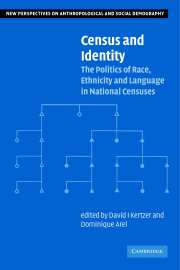Book contents
- Frontmatter
- Contents
- Contributors
- Preface
- 1 Censuses, identity formation, and the struggle for political power
- 2 Racial categorization and censuses
- 3 Ethnic categorizations in censuses: comparative observations from Israel, Canada, and the United States
- 4 Language categories in censuses: backward- or forward-looking?
- 5 Resistance to identity categorization in France
- 6 On counting, categorizing, and violence in Burundi and Rwanda
- 7 Identity counts: the Soviet legacy and the census in Uzbekistan
- Index
- References
3 - Ethnic categorizations in censuses: comparative observations from Israel, Canada, and the United States
Published online by Cambridge University Press: 03 December 2009
- Frontmatter
- Contents
- Contributors
- Preface
- 1 Censuses, identity formation, and the struggle for political power
- 2 Racial categorization and censuses
- 3 Ethnic categorizations in censuses: comparative observations from Israel, Canada, and the United States
- 4 Language categories in censuses: backward- or forward-looking?
- 5 Resistance to identity categorization in France
- 6 On counting, categorizing, and violence in Burundi and Rwanda
- 7 Identity counts: the Soviet legacy and the census in Uzbekistan
- Index
- References
Summary
Censuses and other official documents gather information to carry out a variety of political, economic, and social objectives. In counting and categorizing residents of the state, the census has to cope in an official way with who is defined as a member of the society and how they should be identified in the count. Issues of counting are elementary but not simple. Who is counted as a legitimate resident of the state (e.g., how are non-legal residents and temporary workers treated in official statistics) and what does residence mean (is it limited to de facto residents or are those temporarily living elsewhere included among the state's population) appear on the surface to be straightforward questions, but are at the center of some of the most complex and politically torturous issues facing old and new states. In the global world where movement between states is increasing and taking on new forms, where returning “home” has become more routine, where cases of escape and resettlement can be counted in the millions annually, questions about who are the legitimate residents to be counted in censuses and how they should be classified and categorized are not only technical bureaucratic questions.
Membership in a state involves decisions in the formation of policies. Do particular policies apply only to citizens? Who has representation in local or national governments? Who has rights and entitlements?
- Type
- Chapter
- Information
- Census and IdentityThe Politics of Race, Ethnicity, and Language in National Censuses, pp. 71 - 91Publisher: Cambridge University PressPrint publication year: 2001
References
- 1
- Cited by



